The sheer beauty of simplicity and the luxury of slow living in the most famous city in Southern Italy. The historic centre that surrounds the Domus, a UNESCO World Heritage Site since 1995, is the largest in Europe in size; immerse yourself in centuries of history along its streets (the decumani): a palimpsest of Magna Graecia, Roman, Byzantine, Norman, Swabian, Angevin, Aragon and Bourbon periods. Wander through Spaccanapoli, Piazza del Gesù, Piazza San Domenico, San Gregorio Armeno the street of the nativity cribs and figures, Piazza Dante, Piazza Bellini and nearby artistic and colourful alleys. Visit Piazza Plebiscito, Piazza Trieste e Trento, Palazzo Reale and the Teatro San Carlo. The ideal stay for those who love culture, cities of art, historic houses and Italian food.
The foodie tour passes through via dei Tribunali, the realm of traditional Neapolitan cuisine. You can have lunch and dinner at all hours in the best restaurants and feast on the best street food in the city: pizza of course but also traditional dishes such as pasta al ragù, pasta e patate, genovese (a slow-cooked meat and onion sauce) and tripe. And delicious fried snacks: potato crocchè, pasta frittatine, rice arancini, or a paper cone of fried dough balls and panzarotti – mini fried pizza crescents. Enjoy a panino stuffed with sausage, provola and friarielli (a local broccoli rabe) or aubergine parmigiana, or taralli crackers prepared with almonds, lard and pepper. A feast of cakes and desserts: treat yourself to croissant and brioche for breakfast, rum-flavoured babà, a ministeriale –a liqueur-filled chocolate medallion, sfogliatella pastries filled with ricotta, a slice of pastiera – a sweet ricotta tart flavoured with orange flower water, zeppola di San Giuseppe – sweet deep-fried dough balls with custard and an Amarena cherry, doughnuts, delizie a limone – a nest of sponge cake stuffed with lemon cream, caprese cake, or a fiocco di neve – rum-soaked sponge cake topped with whipped cream and chocolate.
From via Toledo to Chiaia, it’s time for shopping whether for artisan products or designer items. Start from the Galleria Umberto I, the monumental shopping gallery built between 1887 and 1890, by the will of the king, and stroll among the best shops and pastry shops in the city. You can wander up via Toledo or stroll to the Chiaia district, the upscale area of Naples.
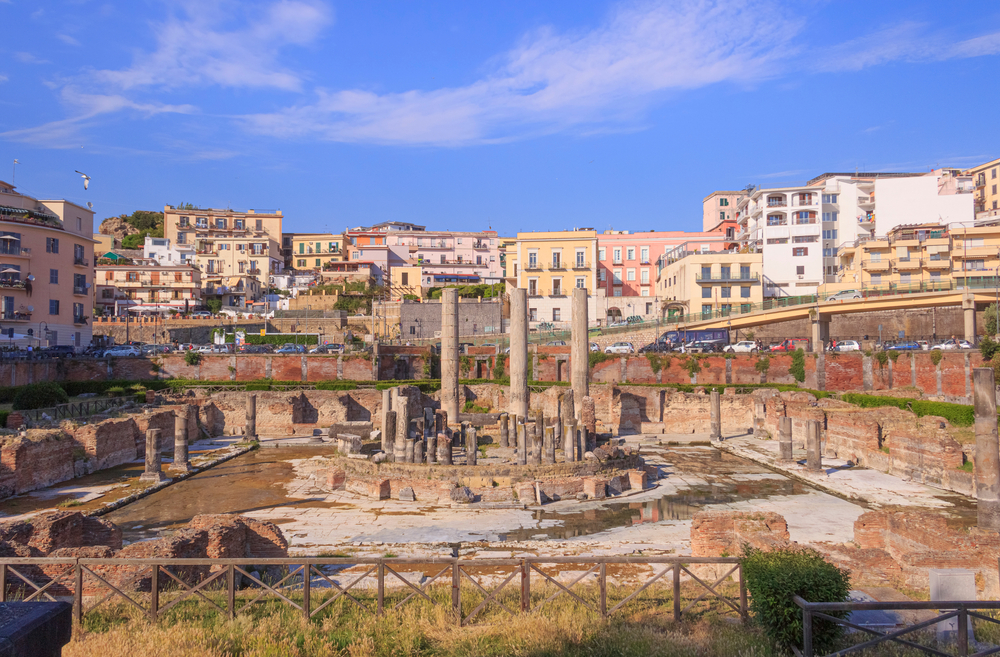
“The most wonderful region
in the world!
Beneath the purest
sky, the most treacherous soil”
Johann Wolfgang Goethe defined the Campi Flegrei like this in 1787.
Campi Flegrei means “the burning plain”, in reference to the volcanic origin of the whole territory, which includes the towns of Pozzuoli, Quarto, Baia di Bacoli, Bacoli and Monte di Procida, (and the islands of Procida and Ischia), all close to Naples. In Roman times, Naples was connected to the Campi Flegrei through the Crypta Neapolitana, a tunnel dug in the tufa rock (in the area that connects Fuorigrotta with Mergellina); at the entrance to the Crypt there is a well-preserved columbarium from the imperial era identified as the tomb of Virgil, here the great Roman poet emerges in our story, setting his epic poem of the Aeneid in the Campi Flegrei.
A visit to the Monumental Park of Terme di Baia is a dive into the splendour of the past, from the ancient thermal baths of the Archaeological Park to the remains of the houses located in the upper area of the park, bringing together the many Roman remains scattered in the area. At the time of the hegemony of Cuma, Baia became one of the most popular holiday resorts for wealthy Roman patricians, who built monumental villas there. They called it “little Rome” where they could enjoy lavish entertainment without rules, just like in the rich villas of the capital.
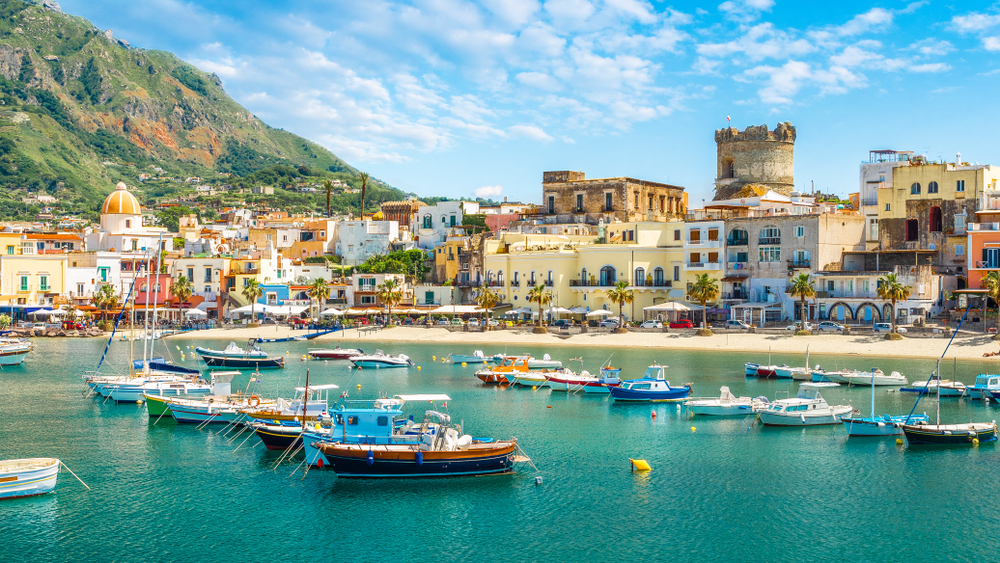
Between the purple mountains sleeping
Naples dressed in white,
Ischia sea waves
As purple cloud;
The snow in the crevasses
Is as a candid study of swans;
Black Vesuvius raises its head
Girdled with red curls.
(Hans Christian Andersen)
Ischia is the “green island”, thanks to its unspoiled nature, gardens, sea, mountains and spas. Myth has it that Typhon, the giant with seven heads and eyes of fire, punished by Zeus, was forced to support the entire island, and every time he tried to rebel, Ischia was shaken by an earthquake. Rich in culture and history, a refuge for intellectuals from all over the world, and the location for famous films, this is the largest island in the Gulf of Naples. Formally there are six municipalities on the island: Ischia with the port and nightlife, the fishing village of Ischia Ponte and the Aragonese Castle, Casamicciola, Lacco Ameno, Forio, Serrara Fontana and Barano. Ischia really offers the visitor everything: wellness and relaxation at its natural spas, a crystalline sea and well-equipped beaches, hikes on Mount Epomeo or strolls along the harbours where luxury yachts are moored, with excellent restaurants, art, entertainment and lots of fun.

When you leave Rome for Capri you pass from one part of the world to another in three hours. It is as if you are crossing an ocean. A leap that would normally take you twelve hours by plane. There is such a radical transformation of the landscape, of the orography, of everything, that you suddenly pass from one dimension to another. And the one you pass through, when you arrive in Capri, is the dimension of the myth. Then this myth was dirtied, degraded, whatever you say. But despite everything…
(Raffaele La Capria)
Located off the Sorrento peninsula, just 30 minutes crossing from Sorrento, Capri, the most glamorous island of the Campania Archipelago, invites you to walk from the famous square to the panoramic terrace with a view of the spectacular limestone crags or sea stacks – the faraglioni. And don’t miss the picturesque town of Anacapri, set at the highest point of the island, before unwinding on the beaches of Marina Grande and Marina Piccola. A tour of the island by sea allows you to discover the natural sea caves lapped by waters of incredible colours, above all the spectacular Blue Grotto with its surprising play of natural light.
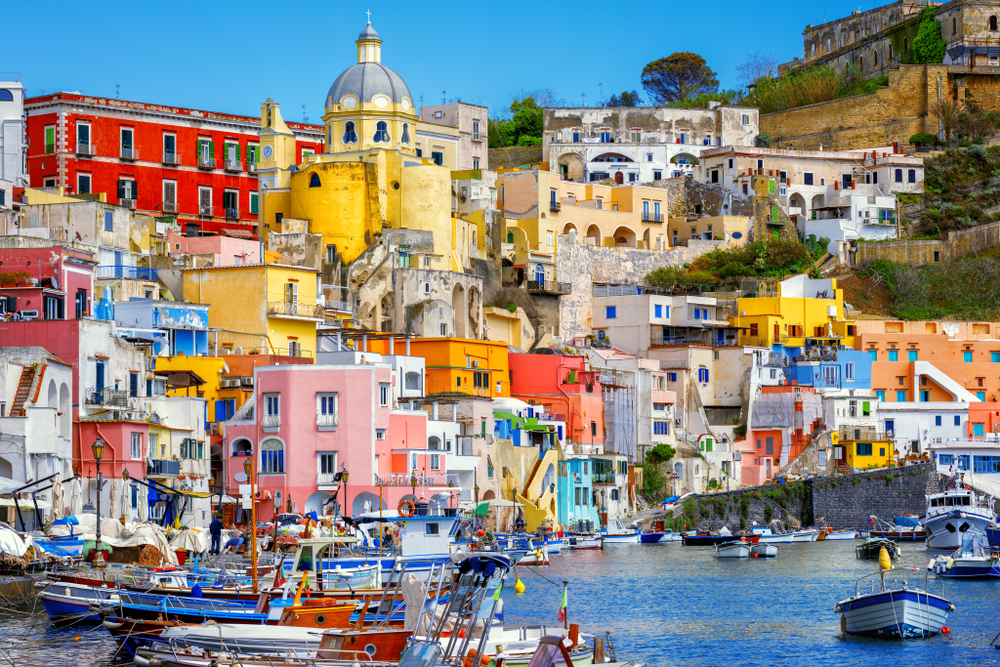
You can save yourself from other women, you can discourage their “love”, but who can save you from your mother? She has the vice of saintliness … she will never tire of atoning for the guilt of having made you, and as long as she is alive, she won’t let you live, with her.
(Elsa Morante – from Arturo’s Island)
Procida, the Italian Capital of Culture in 2022, is the smallest island of the Campania archipelago, famous as the backdrop to cinematic masterpieces such as Il Postino starring Massimo Troisi, which won an Oscar for its soundtrack. It is the setting for “Arthur’s Island” the famous novel by Elsa Morante which won the Italian literary prize the Premio Strega, about a small boy growing up on the island and his white dog Immacolatella. It is the island of “Graziella” the heroine of a novel by Alphonse de Lamartine that tells the story of a young French man who falls for a fisherman’s granddaughter. On arriving at the island, visit the beaches where some of the most beautiful scenes of Il Postino were filmed, such as Pozzo Vecchio beach. The narrow road leading there was renamed by the Municipality of Procida “Via della Spiaggia del Postino” in 2010. The picturesque Marina Corricella is the oldest fishing village on the island. The traditional buildings tumble down the alleys and steps and line the waterfront, their balconies covered by arches of Arab origin. Another famous beach not to be missed is Chiaiolella, on the other side of the small island. Procida is full of charm, to be explored on foot; its characteristic coloured houses and breath-taking views will enchant you. Procida can be reached by ferries and hydrofoils from Naples and Pozzuoli. Not far away is Vivara, a suggestive and mysterious portion of land. Vivara is a magnificent naturalistic oasis, where the Mediterranean maquis thrives, wild and untouched.
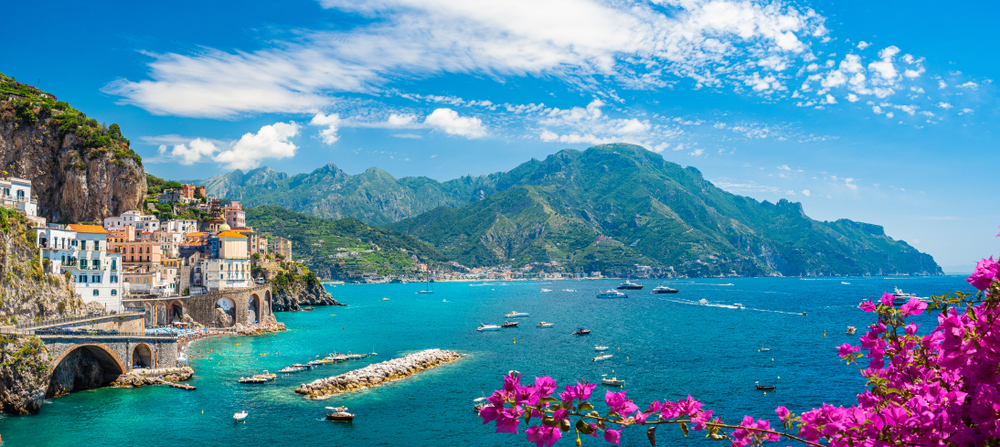
In the dark night
the white moon makes high silence
Torquato Tasso
(taken from the ode Tonight love is silent)
Emerald waters and lemon scents: the Sorrento peninsula stands resplendent in the Gulf of Naples. This evocative coast, which runs from Castellammare di Stabia to the promontory of Punta Campanella, encompasses everything: unspoilt nature, hiking trails, crystal clear sea, beaches, marine reserves and archaeological sites. Beautiful Sorrento is the largest coastal town of the peninsula, perched on a panoramic cliff. Sorrento is also the birthplace of the Renaissance poet and writer Torquato Tasso, get to know more about this great historical figure as remembered and told by the inhabitants. Not far from Sorrento are the ruins of the Roman villa Pollio Felice – dating back to the 1st century BC; the site is famed for its wonderful natural pool, hidden by the rocks and far from prying eyes where centuries later legend has it that the 14th century Queen Giovanna of Naples would meet her young lovers.
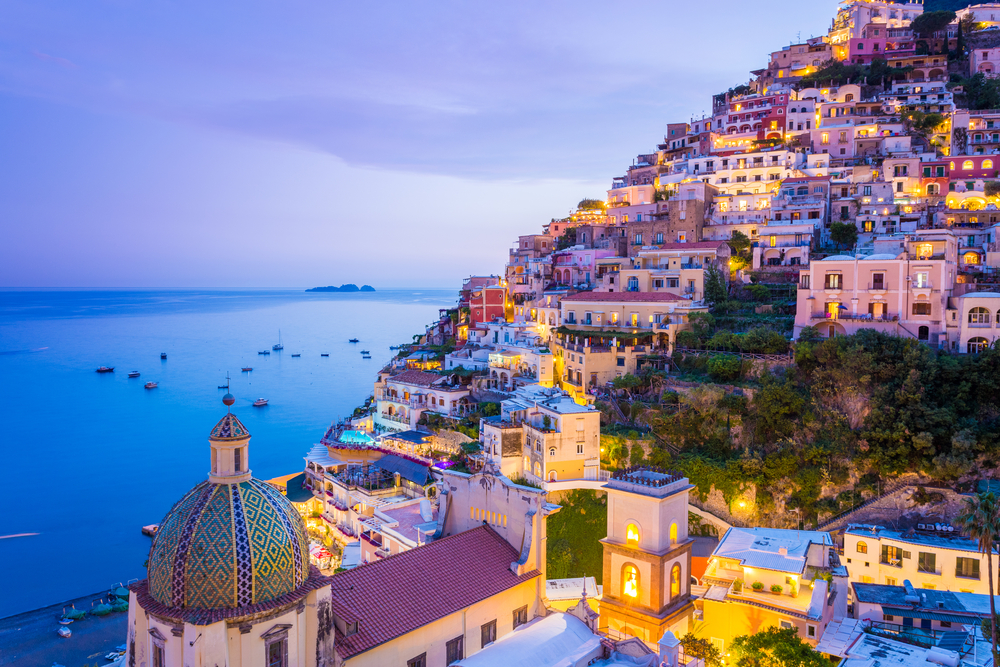
The Amalfi Coast is a dream place that doesn’t seem real (Alberto Moravia)
Picturesque villages overlooking the sea, enchanting bays and hidden beaches, citrus groves, vines and olive trees. From Positano to Vietri sul Mare along the Tyrrhenian coast of southern Italy, stands the beautiful Amalfi Coast in front of the Gulf of Salerno and behind the Lattari Mountains. It is included in the UNESCO World Heritage List as a perfect example of a Mediterranean landscape.
So unique it was described by the writer Corrado Alvaro as “a paradise made of steps, which resound like the keys of an old piano”. It is made up of sixteen beautiful small towns: Amalfi, Atrani, Cava de’ Tirreni, Cetara, Conca dei Marini and its Emerald Grotto, Furore, Maiori, Minori, Praiano, Positano, Raito, Ravello, Sant’Egidio del Monte Albino, Scala, Tramonti and Vietri sul Mare. The landscape is unique and of great cultural and natural value, thanks to its important food and wine tradition: the wine and lemons of Amalfi and the anchovies of Cetara, typical dishes of Mediterranean cuisine.
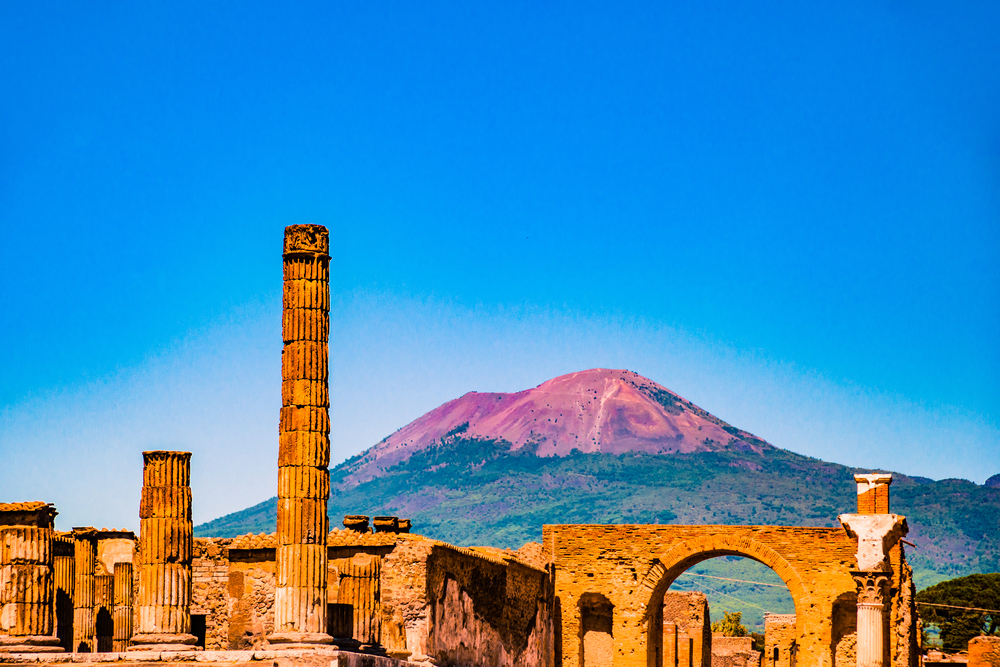
Pompei like any other town. Same old humanity. All the same whether one be dead or alive. Pompei comfortable sermon. Like Pompei better than Paris.
Herman Melville (from his travel journals)
The UNESCO site includes three different archaeological areas: the ancient towns of Pompeii and Herculaneum together with the Villa of the Mysteries and the Villa of the Papyri, and the nearby Villa of Poppaea and Villa of Lucius Crassius Tertius in Torre Annunziata, the ancient Oplontis. The vast expanse of the site of Pompei provides a complete picture of a flourishing ancient Roman commercial town. This contrasts with the smaller but better-preserved remains of the holiday resort of Herculaneum. The superb wall paintings of the Villa Oplontis at Torre Annunziata give a vivid impression of the opulent lifestyle enjoyed by the wealthier citizens of the Early Roman Empire.
When Vesuvius erupted on 24 August AD 79, it engulfed the two flourishing Roman towns of Pompei and Herculaneum, as well as the many wealthy villas in the area.
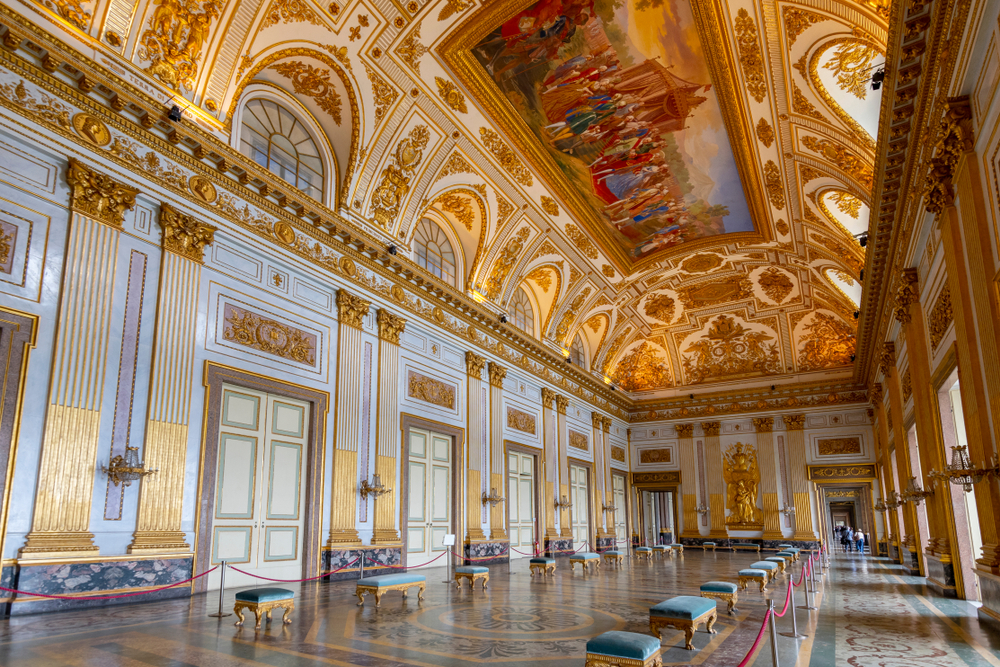
Caserta owes its fame to the palace. The charm of this Neapolitan Versailles, built by Charles III in the mid-eighteenth century, comes from the architecture of Vanvitelli, the sumptuous staircase, the court theatre, the large apartments, and the perspective of arches and marble.
Guido Piovene
The Royal Palace of Caserta is one of the 100 most visited monumental complexes in the world.
An exceptional example of a Baroque royal residence, it was built according to the wishes of Charles of Bourbon to rival French palaces, above all Versailles.
Planned from 1752 by the architect Luigi Vanvitelli, the Bourbon Palace is a triumph of marble, gilded decorations and paintings and includes a sumptuous park of more than 3km, with gardens, sculptures, fountains and waterfalls. The Royal Place has two imposing and elegant facades, one facing the outside on the great piazza d’Armi, the other overlooking the park. A beautiful and spectacular marble staircase leads to the first floor, to reach the royal apartments and the palatine chapel.
The majestic staircase and some rooms of royal Palace have n been used as film sets for the most famous cinema productions> just to name three: Star Wars, Angels and Demons, and Mission Impossible.